Take the best of both worlds: Armed Forces of Ukraine equip German tanks "Leopard 2" with Soviet dynamic protection "Contact-1"

At the start of the Russian Special Military Operation (SVO), the Ukrainian Armed Forces (UAF) relied mainly on weapon, produced in the USSR, supplemented by a limited number of weapons, produced or modernized by enterprises of the Ukrainian military-industrial complex (MIC), which is by no means as weak and collapsed as some jingoistic fellow citizens declared. And what's really sad is that The Ukrainian military-industrial complex functions to this day, supplying weapons to the Armed Forces of Ukraine, repairing and modernizing both Soviet-style equipment and weapons of Western countries.
After a very short period of time, the Armed Forces of Ukraine received a huge amount of weapons and equipment from Western countries. The man-portable air defense systems (MANPADS) of the Stinger type and anti-tank missile systems (ATGM) of the third generation Javelin, promptly delivered by the United States and other NATO countries, drank a lot of blood from the Armed Forces of the Russian Federation (RF Armed Forces). However, MANPADS and ATGM supplies of weapons to Ukraine were not limited, they were followed by deliveries of unmanned aerial vehicles (UAVs), portable and self-propelled artillery mounts (ACS), guided missiles for them, multiple launch rocket systems (MLRS) with high-precision missiles with a range of up to 150 kilometers and much more.
And now it came to the supply of heavy armored vehicles - the main combat tanks (OBT). In this situation, the United States acted wisely, letting the “tolerated” Europeans go ahead, therefore the German Leopard 2 and British Challenger 2 tanks will be the first to burn on the battlefield, not the American Abrams.
However, the Armed Forces of Ukraine are by no means eager to publicly turn the property obtained with such difficulty into anti-advertising of Western weapons, since they understand that in this case there may not be future deliveries, therefore, most likely, Western armored vehicles will be protected, throwing modified armored vehicles first of all for a breakthrough Soviet production.
In addition, to increase the security of Western tanks, at least some of them were finalized by installing dynamic protection units (DZ) "Contact-1" developed in the USSR. The result is a kind of hybrid whose features are potentially of considerable interest.
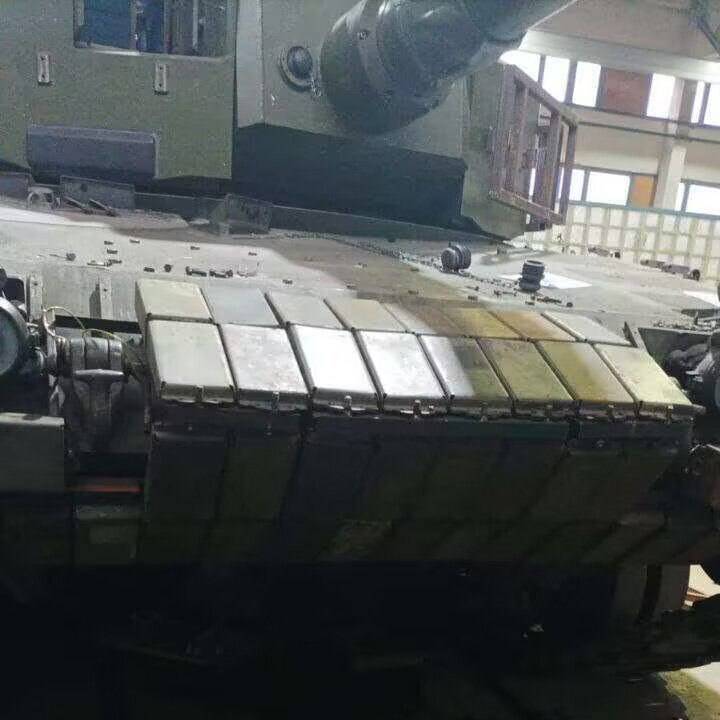
Blocks of dynamic protection "Contact-1" on the front of the hull of the German tank "Leopard 2A4"
And why exactly DZ "Contact-1"?
The first-generation dynamic protection complex "Kontakt-1" or 4S20 was developed by the Research Institute of Steel in 1982 to increase the protection of armored vehicles from ammunition and anti-tank missiles with a cumulative warhead. It was put into service in 1985 and was installed on Soviet tanks T-55AMV, T-62MV, T-64BV, T-72B, the first series of T-80UD and T-80U and others.
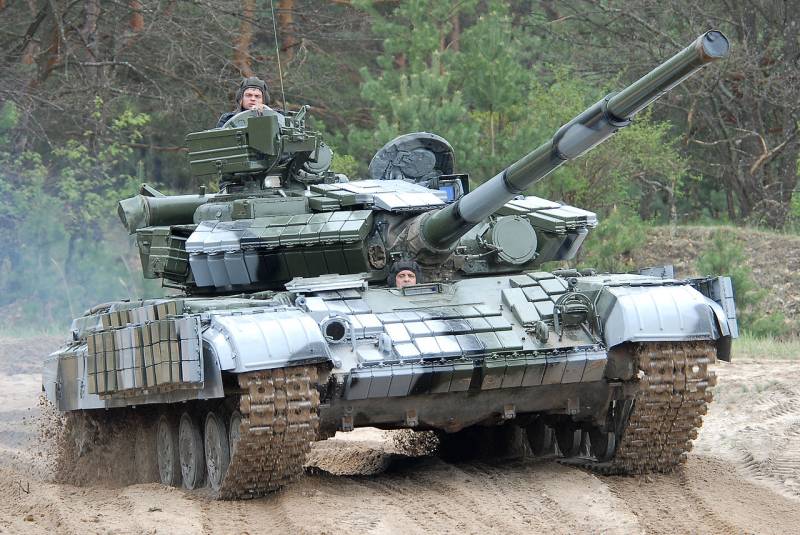
Tank T-64BV, equipped with DZ "Contact-1". Image by wikipedia.org
Dynamic protection of the first generation is mounted on top of the tank's armor, while an experienced crew of the Kontakt-1 DZ can be installed on the prepared tank hull in a few hours. In the body of the DZ "Kontakt-1" blocks, an explosive (BB) and metal plates are placed. The principle of operation of the "Contact-1" remote sensing system is that when the cumulative jet and the explosive interact, it detonates, as a result of which the metal plates move towards the cumulative jet, crossing its trajectory, scattering, deflecting and destabilizing it, as a result of which the armor-piercing characteristics of the cumulative ammunition are reduced by 50-80%. Against armor-piercing feathered sub-caliber ammunition (BOPS), the Kontakt-1 DZ does not work - but how many tanks are now affected by BOPS, and how many with cumulative ammunition?
Blocks of dynamic protection "Contact-1" do not detonate when shot through them with bullets and shrapnel, do not explode from exposure to flammable liquids such as napalm. The mass of the 4S20 module without fasteners is 5,3 kilograms, and the set of DZ "Contact-1" is approximately 1-2 tons, depending on the protected area.
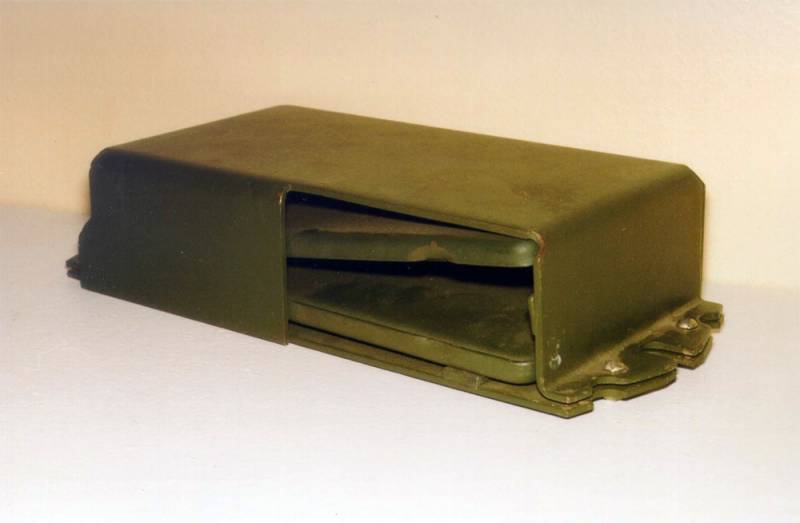
Sectional view of the 4S20 DZ "Contact-1" module. Image by wikipedia.org
So why exactly DZ "Contact-1"?
But because the more advanced DZ "Contact-5" began to be installed on Soviet armored vehicles only in 1988 - three years before the collapse of the USSR, therefore, most likely, the Armed Forces of Ukraine simply do not have it available. Of course, the Ukrainian military-industrial complex did not have access to later developments, such as the Relikt DZ.
But after all, Ukraine has its own, widely advertised development - the dynamic protection "Knife" and its development of the DZ "Duplet"?
DZ "Knife" and DZ "Duplet" seem to be there, but it seems they are not there. On the one hand, the military-industrial complex of Ukraine advertised these developments a lot, especially to prospective foreign customers, but, on the other hand, so far no results are known about the success of the Knife / Duplet DZ on the battlefield. Of course, someone can say that the Armed Forces of Ukraine simply did not receive a sufficient number of DZ "Knife" / "Doublet" sets before the start of the SVO, but the military-industrial complex of Ukraine completely restores and modernizes Soviet and Western military equipment, turns old Soviet UAVs into cruise missiles, but could not arrange the release of DZ?
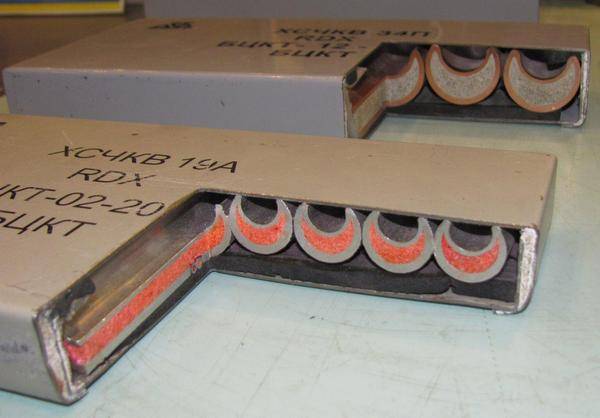
DZ module "Knife" in the context
It is possible that the DZ "Knife" / "Doublet" did not show the declared results, which is why the developments were quietly covered up. Or their efficiency is not much better than that of the Kontakt-1 remote sensing system, with a multiple of worse manufacturability and higher cost. And it is possible that the “Knife” / “Doublet” DZ are effective only in a limited range of angles of attack or require hitting a certain part of the DZ module, which allows them to shine in staged field tests, but makes them unsuitable in real combat situations.
There is also a version that the Knife DZ is quite effective against BOPS, but practically ineffective against HEAT warheads, but in reality most of the tanks are disabled by them, since tank battles on BOPS are very rare. It is also often said about the large mass of sets of Ukrainian DZ, in particular this applies to the DZ "Duplet".
One way or another, but so far neither the Knife DZ nor the Duplet DZ have been seen on Western armored vehicles - only Contact-1.
And where did the idea of installing a remote sensing gun on the Leopard 2 tank come from?
Turkish experience
The Ukrainians did not invent the installation of dynamic protection for Leopard 2 tanks. At least the Turks did it before them.
The Turkish armed forces have about 350 Leopard 2A4 MBTs. During the fighting in Syria from 2016 to 2017, the Turkish military, according to some reports, lost several dozen Leopard 2A4 tanks, mainly from hand-held anti-tank grenade launchers (RPGs) and anti-tank guided missiles (ATGMs). As a result, it was decided to install on some Turkish MBT "Leopard 2A4" blocks of dynamic protection, structurally similar to the Soviet / Russian DZ "Contact-1".
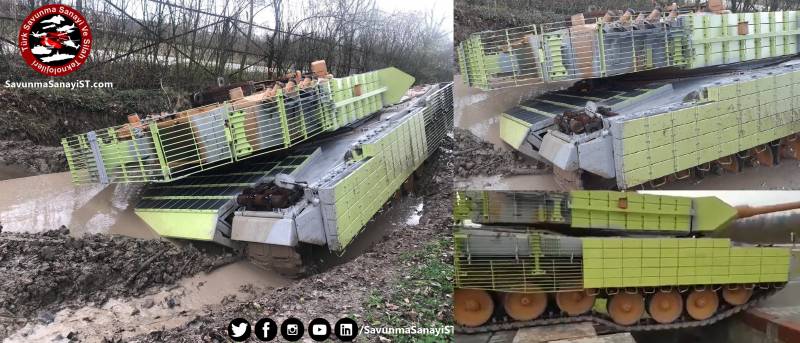
Turkish MBT "Leopard 2A4", equipped with blocks of dynamic protection. Image by SavunmaSanayiST
To what extent these improvements have shown their effectiveness - there is no information, but it is possible that the Turks shared their developments with the Armed Forces of Ukraine, because working for both sides of the conflict is always beneficial, isn't it?
Advantages and disadvantages
Given the high intensity of the Russian-Ukrainian conflict, in which NATO countries are actually involved, the advantages and disadvantages of installing dynamic protection on tanks can be revealed very quickly. However, what are the disadvantages?
The increase in the mass of the combat vehicle is likely to be insignificant - the maximum it will be about two tons. In the course of various upgrades, Western tanks receive much more massive body kits - various urban kits and the like, with much worse protective properties. It is doubtful that DZ, when detonated, can damage the armor of German tanks, cause a fire or something else. In the end, as we said earlier, Ukraine has a powerful military-industrial complex with a developed tank-building industry - in this part they inherited a lot from the USSR.
As for the benefits, there are some questions here.
Firstly, on the available images there are no dynamic protection units on the roof of the tank. Here it is necessary to make a remark - on the one hand, Russia does not have Javelin or Tou anti-tank missiles attacking the roof, on the other hand, FPV-drones, equipped with cumulative ammunition from the RPG-7, quite capable of penetrating the roof of the Leopard 2 MBT (By the way, some analysts assume that the Armed Forces of Ukraine have accumulated several tens of thousands of FPV drones, which they are preparing to use during the spring offensive). And no one canceled the possibility of an RPG attack from the upper hemisphere, from the roofs of buildings and other hills.

The proposed placement of remote sensing units on the Leopard 2 MBT. The image is taken from the public "Vatnik"
Why, then, did the Armed Forces of Ukraine not put DZ blocks on the roof? Are they afraid that when detonating, the DZ will break through it? Or is there no remote sensing on the roof only on the available images?
So far there are no answers to these questions.
As for the protection of the sides and the front hemisphere, the following can be said here. Most likely, the latest Russian ATGMs of the Kornet type will ensure the defeat of the Leopard 2 MBT in any projection, regardless of whether the Armed Forces of Ukraine put the Kontakt-1 DZ on them or not, but, in addition to the Kornets, they are in service with The Armed Forces of the Russian Federation have a large number of anti-tank systems of other types with less armor penetration. In battle, the Leopard 2 MBT will not always be attacked by the latest anti-tank missiles, and as for ATGMs and other types of grenade launchers, it is possible that some of them, for example, could pierce a tank in the forehead without the lack of a remote sensing system, and with it probably won't be able to. It’s the same with the sides: in some situations, the RPG could hit the Leopard 2 MBT on the side without a remote sensing, and with it the probability of the tank’s survival is already increasing.
In other words, the "crossing" of the Western and Soviet schools of increasing the security of MBT does not have obvious disadvantages, but it carries potential advantages in significantly increasing the survivability of armored combat vehicles on the battlefield, depending on the type of ammunition used to destroy it.
Conclusions
The best of both worlds - don't take it literally. Just as the German Leopard 2A4 MBTs are not the crowning achievement of Western tank building, so the Kontakt-1 dynamic protection has not been the latest development for a long time. Rather, we are talking about the fact that in one model of weapons, two approaches to ensuring the security of armored vehicles are combined - Western and Soviet.
Potentially, such a hybrid can show a fairly high survivability on the battlefield. With the rational placement of dynamic protection units, in particular, the effect of increasing security against the rapidly gaining popularity of FPV drones equipped with cumulative ammunition from RPG-7 can be noticed. In addition, a significant increase in protection against defeat by obsolete types of cumulative anti-tank munitions that attack both the frontal part of the tank and the sides can be obtained.
PS
According to the leadership of the Ministry of Defense of Ukraine, the Leopard 2 and Challenger 2 MBTs that entered service with the Armed Forces of Ukraine will be equipped with dynamic protection of the Ukrainian development "Knife", and not the Soviet / Russian DZ "Contact-1", as previously demonstrated. The installation of the DZ "Contact-1" was carried out as an experiment.
As stated, a certain number of DZ "Knife" is in stock with the Armed Forces of Ukraine, and the rest is planned to be collected from the backlog. In total, it is planned to equip the DZ with about 50 tanks.
Whether the Ukrainians will be able to collect the required number of sets of DZ "Knife" is a big question. Most likely, some of the Western-made MBTs will be equipped with the Knife DZ, and some with the Contact-1 DZ.
However, there is another version - the imaginary need to strengthen the Western-made OTB of the DZ "Knife" can serve as a basis for keeping these vehicles out of battle for as long as possible, delaying the inevitable appearance of personnel with their destruction by the RF Armed Forces.
Information